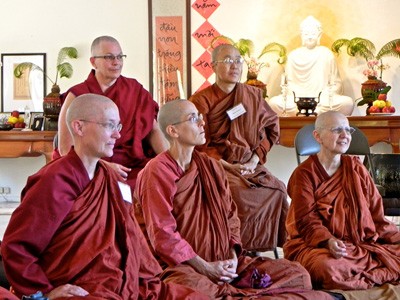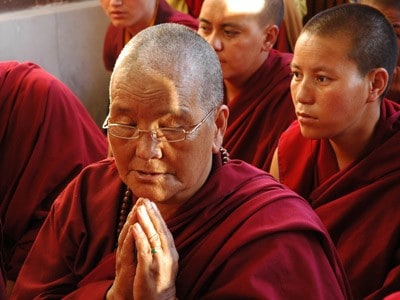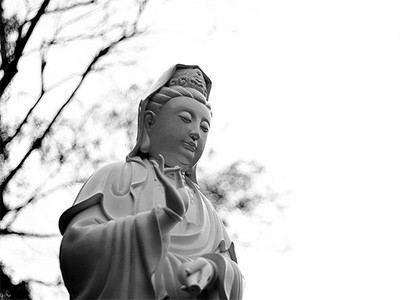Ordination of nuns by monks

Here is the passage in the bhikkhunikkhandhaka that allows ordination of bhikkhunis by bhikkhus:1
Atha kho mahāpajāpatī gotamī yena bhagavā tenupasaṅkami. Upasaṅkamitvā bhagavantaṁabhivādetvā ekamantaṁaṭṭhāsi. Ekamantaṁṭhitā kho mahāpajāpatī gotamī bhagavantaṁ etadavoca: ‘kathâham-bhante imāsu sākiyānīsu paṭipajjāmī’ti. Atha kho bhagavā mahāpajāpatiṁ gotamiṁ dhammiyā kathāya sandassesi samādapesi samuttejesi sampahaṁsesi. Atha kho mahāpajāpatī gotamī bhagavatā dhammiyā kathāya sandassitā samādapitā samuttejitā sampahaṁsitā bhagavantaṁ abhivādetvā padakkhiṇaṁ katvā pakkāmi. Atha kho bhagavā etasmiṁ nidāne etasmiṁ pakaraṇe dhammiṁ kathaṁ katvā bhikkhū āmantesi: ‘anujānāmi bhikkhave bhikkhūhi bhikkhūniyo upasampādetunti.2
Then Mahāpajāpati Gotamī approached the Blessed One. Having approached and bowed down to the Blessed One she stood to one side. Standing to one side she said this to the Blessed One: “How, bhante, am I to practice with regard to these Sakyan women?’ Then the Blessed One inspired, roused, uplifted and exhorted Mahāpajāpati Gotamī with talk on Dhamma, and having bowed down she left keeping her right side towards him. Then the Blessed One having given a Dhamma talk addressed the bhikkhus with regard to that reason, with regard to that cause saying: ‘I allow, bhikkhus, bhikkhunīs to be given acceptance by bhikkhus’.
This is quite straightforward. After a substantial intervening section, there are further details on bhikkhuni ordination. Here we find the following:
Tena kho pana samayena bhikkhū bhikkhunīnaṁ antarāyike dhamme pucchanti. Upasampadāpekkhāyo vitthāyanti, maṅkū honti, na sakkonti vissajjetuṁ. Bhagavato etamatthaṁ ārocesuṁ. “Anujānāmi, bhikkhave, ekato-upasampannāya bhikkhunisaṅghe visuddhāya bhikkhusaṅghe upasampādetun”ti.3
Now on that occasion the bhikkhus ask the bhikkhunis regarding the obstructive dhammas. The women seeking ordination were embarassed and ashamed and were not able to answer. The Blessed One declared regarding this matter: ‘I allow, monks, by [a woman] who has been accepted on one side in the bhikkhuni Sangha and is purified [regarding the obstructive dhammas] to be accepted in the bhikkhu Sangha.’
Following this are the details for bhikkhuni ordination, the various procedures and statements. From here on, it is assumed that bhikkhuni ordination is normally done on both sides. There is mention of a bhikkhuni ‘accepted on [only] one side’, for example:
Ekato-upasampannābhikkhunisaṅghe, visuddhā…4
One accepted on one side in the bhikkhuni Sangha, and pure… ’
In the detailed definition of ‘bhikkhuni’in the bhikkhuni Vinaya there is no mention of one accepted ‘on one side’:
Bhikkhunīti bhikkhikāti bhikkhunī; bhikkhācariyaṁ ajjhupagatāti bhikkhunī; bhinnapaṭadharāti bhikkhunī; samaññāya bhikkhunī; paṭiññāya bhikkhunī; ehi bhikkhunīti bhikkhunī; tīhi saraṇagamanehi upasampannāti bhikkhunī; bhadrā bhikkhunī; sārā bhikkhunī; sekhā bhikkhunī; asekhā bhikkhunī; samaggena ubhatosaṅghena ñatticatutthena kammena akuppena ṭhānārahena upasampannāti bhikkhunī. Tatra yāyaṁ bhikkhunī samaggena ubhatosaṅghena ñatticatutthena kammena akuppena ṭhānārahena upasampannā, ayaṁ imasmiṁ atthe adhippetā bhikkhunīti.5)
‘Bhikkhuni’ means: ‘she is an alms-food eater’–thus she is a bhikkhuni; ‘she has entered the life of alms-food’–thus she is a bhikkhuni; ‘she wears the patched robes’–thus she is a bhikkhuni; ‘by designation’–thus she is a bhikkhuni; ‘by her acknowledgement’–thus she is a bhikkhuni; ‘[by saying:] come bhikkhuni!’–thus she is a bhikkhuni; ‘she is accepted by going for the three refuges’–thus she is a bhikkhuni; ‘she is auspicious’–thus she is a bhikkhuni; ‘she is the essence’–thus she is a bhikkhuni; ‘she is a trainee’–thus she is a bhikkhuni; ‘she is an adept’ – thus she is a bhikkhuni; ‘she is accepted in harmony by both Sanghas with a formal Act with a motion and three announcements which is unshakeable and fit to stand’–thus she is a bhikkhuni. Herein, whatever bhikkhuni is accepted in harmony by both Sanghas by a formal Act with a motion and three announcements which is unshakeable and fit to stand, this is what is meant by ‘bhikkhuni’ in this context.’
Neither is one accepted on ‘one side’ found in the shorter definition in the bhikkhu Vinaya:
Bhikkhuniyo nāma ubhatosaṅghe upasampannā.6
‘Bhikkhuni’ means one fully accepted in both Sanghas.
Nevertheless, in the next line, in discussing the offences falling for exhorting bhikkhunis without permission of the Sangha, there is mention of bhikkhunis accepted on ‘one side’:
Ekato-upasampannaṁovadati, āpatti dukkaṭassa
One exhorts one accepted on one side, an offence of wrong-doing.
So the bhikkhuni accepted on one side is occasionally acknowledged, but was certainly not mainstream. In all the contexts it appears, it clearly implies she is accepted in the bhikkhuni Sangha (ekato-upasampannābhikkhunisaṅghe, visuddhā…). I do not believe there is any context, after the allowance for ordination on both sides, that acknowledges one ordained only by the bhikkhus. It seems that the normal process was that one would ordain in the bhikkhuni Sangha, then in the bhikkhu Sangha. Sometimes this process might be interrupted, for example if there were dangers preventing her from travelling to the bhikkhu Sangha for ordination.7 During this interval she would be accepted on ‘one side’.
Nevertheless, it remains the indisputable fact that the allowance for ordination by bhikkhus alone is there, and it is never rescinded. This contrasts with the situation in the bhikkhu ordination procedure. The first allowance is for the going forth and ordination by three refuges:
Anujānāmi, bhikkhave, imehi tīhi saraṇagamanehi pabbajjaṁupasampadaṁ.8
I allow, monks, the going forth and acceptance by these three goings-for-refuge
Later this is rescinded:
Yā sā, bhikkhave, mayā tīhi saraṇagamanehi upasampadā anuññātā, taṁajjatagge paṭikkhipāmi. Anujānāmi, bhikkhave, ñatticatutthena kammena upasampādetuṁ.9
Monks, that acceptance by the three goings-for-refuge that I allowed, from today I rescind. I allow, monks, acceptance by a formal Act with a motion and three announcements.
This is quite straightforward. But the situation with the bhikkhunis is less definitive. The allowance for acceptance by bhikkhus only is clearly stated and never rescinded, but the text proceeds as if it no longer applied. I would understand this as most likely just a slight editorial sloppiness in treating the bhikkhuni procedure. It could not be argued that such an ordination by the bhikkhus only would be the ‘best practice’ according to the Pali Vinaya. But neither could it be maintained that it was unallowed.
Bhikkhu Sujato
Bhikkhu Sujato was ordained in 1994 as a Theravada monk in the Thai forest lineage of Ajahn Chah. He lived as a monk in Thailand for some years and then returned to his native Australia, serving as abbot of Santi Forest Monastery, which he founded in 2003. Bhikkhu Sujato is the co-founder of SuttaCentral, which offers freely available translations of the four Nikāyas, as well as the author of numerous books on early Buddhism. He has worked to revive the full ordination of nuns in Theravada traditions. He is particularly interested in exploring the path of the Buddha in a time of climate change, globalized consumerism, and political turmoil.


